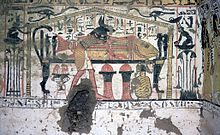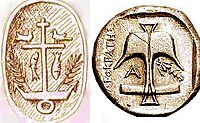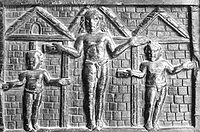Christian symbolism
The definition and preservation of the dogmas of the faith demanded great caution in an environment as diverse and as quick to syncretism as that of the Roman Empire in those centuries. The catechumens had been divided into two groups: listeners (audientes), who wanted to be initiated into the faith, among whom there were sometimes spies for hire, but who delayed baptism, and elect (electi), who were already preparing for their entry into the Christian community. Both of them, although the latter were more educated, had to stay out of the rites reserved for initiates and especially the "mystery" of the flesh and blood of the Word of God. Hence, to recognize themselves, the faithful "initiated" will use symbols.
Origin
Some authors consider that some symbols could be derived from ancient mythology. The turkey and the Phoenix bird symbolize the resurrection. Palm victory. The dove Christian simplicity, modesty and peace granted to the faithful soul. The deer, the diligent servant of Christ. The anchor, the hope of salvation. The nave, the Church. Orpheus, symbolized Jesus Christ.
It is believed that in early Christian symbology (2nd and 3rd centuries AD) the sign of the anchor or "ancora" It would be a veiled way of referring to the cross of Christ, this, with the intention of hiding his faith in times of persecution, such as that unleashed in the days of Emperor Diocletian.
Christian symbols were: The fish. Objects that have been dated to the II century d. bearing figures of fish together with the Greek word for fish, “ΙΧΘΥΣ (IKHTHUS or IKHTHYS)”, which is believed to be a cryptic for the Greek expression “Iesoús Christós Theoú Yiós Sotḗr ”, which means “Jesus Christ, Son of God, Savior.”
According to The Interpreter’s Dictionary of the Bible, fish featured frequently in ancient pagan symbolism, often apart from water scenes. "In such cases," he says, "it would seem to have symbolic meaning, possibly to represent a deity, power, fecundity, etc." This same reference work further says that certain Jews adopted the symbol of the fish from some Gentile religious customs, adding: “It is probable that the above considerations explain to some degree the appearance of the fish in the art of the earliest Christian catacombs.. We do not know when the Greek word for 'fish' (ikhthys) came to be interpreted as a cipher for 'Jesus Christ, Son of God, Savior';[…] but once this identification was made, the fish became a symbol normal Christian.”
Since the III century, there began to be more explicit representations, such as a carnelian jewel showing the crucifixion of Christ with the twelve apostles, III or IV century AD. C., from the photographic collection and annotations of the classical archaeologist Sir John Beazley.
Today Christianity is full of symbols; the cross is reminiscent of the crucifixion, the virgin Mary personifies the purest form of motherhood reinforced by the association of the color blue and white, as in Isis. The horned and tailed figure is the most common symbolic representation of the devil, intensified by the color red (as Red Set). The creation of icons was considered a very important part of the cult. The lamb, symbol of Christ's sacrifice and his victory, and the Good Shepherd, symbol of Jesus Christ and Orpheus. Some symbols were historical-biblical in theme, such as the sacrifice of Isaac, which was used to represent the sacrifice of the cross; Adam and Eve, image of Jesus Christ, new Adam who repaired sin; Noah's Ark, image of the Church, etc. Sometimes allegorical scenes were also used, such as those of the vineyard, the gathering or dinner, the prudent and imprudent virgins in the parable, etc.
The popular belief that the catacombs, underground cemeteries common to various cities of the empire, were sometimes used as a refuge for Christians in times of persecution has been dismissed by modern historiography.
"Today it is difficult to maintain the character of refuge that has been given to the catacombs, since, except for the three great persecutions of Decius in 250, of Valerian in 257-258 and of Diocletian between late From the third century and beginning of the fourth, Christians enjoyed periods of relative tranquility. The catacombs should be seen as underground cemeteries dedicated to the deceased and to the martyrs, in whose honor the Eucharist was celebrated, as places of rest awaiting the resurrection, and therefore the paintings that decorate them are full of suggestions to the afterlife and the Eucharistic celebration".
Like other communities, Christians also buried their dead there, and in them they also found burials for the bodies of the martyrs, killed in the persecutions. The veneration that began to be paid to them led to the construction of larger chapels between the narrow underground corridors, often superimposed on several floors, and made Christians gather in them to celebrate the mysteries of the faith. Primitive Christian art found an opportunity to capture its admirable achievements on the walls of these halls and chapels.
Next to the ancient Via Appia are the catacombs of San Callisto, San Sebastián and Pretextato; on the Via Ardeatina, those of Domitila, those of Priscilla on the Via Salaria and those of Sta Agnes on the Nomentana. All of them, much visited by pilgrims and tourists who come to Rome, do not represent more than a minimal part of the sixty that are known today, with more than six hundred kilometers of underground galleries with a labyrinthine floor plan, with four or five tombs per floor, one above the other, like the niches of a modern cemetery.
Their assemblies, which were generally held in the tituli or houses of nobles, who willingly provided them for it, were also held in the tombs of the martyrs. It began with the traditional greeting: "Peace be with you" to continue with the recitation of the litanies, which the people answered in chorus; followed by two short prayers, various readings, singing of a psalm, and prayer and commentary on the Gospel. Public confession of sins and the song of the Marhanatha. When this first part concluded, the catechumens and pagans were dismissed. Then the ceremony continued with the offertory (in which the assistants offered their presents or alms) and the preparations for the sacrifice continued, recitation of various prayers, including the Eucharist and communion under the two species (fragment of consecrated asimo bread deposited in the right hand of each communicant by the bishops, and a sip of wine from the chalice that was passed, one by one, by the deacons) Prayer of thanksgiving, episcopal blessing to the faithful, and the farewell formula that still exists: "Go, the mass has ended".
Christian Cross
The Christian Cross is a very familiar religious symbol in Christianity. This method of execution was common for Roman slaves and non-Roman criminals. The gospel uses the words stauros (stake) and xylon (wood).
The words "cross" and "crucifix" come from derivations of the Latin verb cruciare, which means "torture". In the 2nd century the Neoplatonic theological concept of the Cross as the limit of the Pleroma is developed.
Contenido relacionado
The Cure
Paul Cezanne
George Harrison



